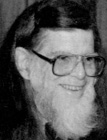Historic ACMI Biography

Obituary: Eugene Ackerman (1920 – 2014), Emeritus Professor of Laboratory Medicine and Pathology at the University of Minnesota, died in his sleep at home in Minneapolis on September 25. Born in 1920 in Brooklyn NY, he studied Physics at Swarthmore College and Brown University, where he met and married Dorothy Hopkirk in 1943. His studies were interrupted by serving as a Conscientious Objector during World War II. After completion of a doctoral degree in Biophysics at the University of Wisconsin-Madison, he joined the Physics faculty at Pennsylvania State University, with several sabbaticals at the University of Pennsylvania in the Biophysics laboratory of Dr. Britton Chance.
In 1960 he became Associate Professor of Biophysics at Mayo Clinic, working on mathematical models of physiological systems. He was instrumental in obtaining one of the first National Institutes of Health (NIH) resource grants for Biomedical Computing Facilities, followed by many research grants modeling ultrasonic behaviors of cells, enzyme kinetics, blood glucose regulation, and patterns of infectious disease epidemics. As adjunct Professor of Biophysics and Computer Science at the University of Minnesota, he developed a Mayo satellite program awarding a MS degree in Biophysics.
In 1967 he left Mayo Clinic for the University of Minnesota, becoming Hill Family Foundation (now Northwest Area Foundation) Professor of Biomedical Computing and Professor of Biometry. A NIH grant to establish a Biomedical Computing Facility had been awarded to the University of Minnesota in 1965, and Eugene Ackerman became its director in 1968 after the illness of its first director, Dr. Eugene Johnson. With the establishment of the Academic Health Center in 1969, the entire biomedical computing program became the Division of Health Computer Sciences in the Medical School’s Department of Laboratory Medicine. Charged with developing core and collaborative research, training, dissemination and a service unit, the growing cadre of informatics faculty, fellows and graduate students helped develop departmental computer systems in the clinical laboratories, surgery, electrocardiography, pulmonary function, and nuclear medicine.
Gene was a superlative scientific educator and writer. One of the first and longest funded National Library of Medicine training grants in health computing was awarded to the University of Minnesota, which eventually trained over a hundred fellows from the health sciences, including ones from medicine, nursing, pharmacy, dentistry and public health. Gene personally directed the graduate theses of nearly a hundred students and postdoctoral fellows. Over his long career, he published hundreds of journal articles, conference abstracts, book chapters and monographs; as well as three books: Biophysical Science (in two editions), Mathematical Models in the Health Sciences, and Simulation of Infectious Disease Epidemics. He was editor of the Biophysical Journal from 1984-1987, and was elected to fellowship in the American College of Medical Informatics in 1985. Gene’s pioneering work in the field of Health Informatics will be recognized next year, as the University of Minnesota celebrates the Fiftieth Anniversary of the educational and research program that he helped initiate.
Retiring in 1991 from the University of Minnesota, Gene Ackerman continued to be active in the Religious Society of Friends (Quakers), and the Minnetonka Computer Interest Group, writing family letters and making weekly visits to the Minnesota Landscape Arboretum.
In 1960 he became Associate Professor of Biophysics at Mayo Clinic, working on mathematical models of physiological systems. He was instrumental in obtaining one of the first National Institutes of Health (NIH) resource grants for Biomedical Computing Facilities, followed by many research grants modeling ultrasonic behaviors of cells, enzyme kinetics, blood glucose regulation, and patterns of infectious disease epidemics. As adjunct Professor of Biophysics and Computer Science at the University of Minnesota, he developed a Mayo satellite program awarding a MS degree in Biophysics.
In 1967 he left Mayo Clinic for the University of Minnesota, becoming Hill Family Foundation (now Northwest Area Foundation) Professor of Biomedical Computing and Professor of Biometry. A NIH grant to establish a Biomedical Computing Facility had been awarded to the University of Minnesota in 1965, and Eugene Ackerman became its director in 1968 after the illness of its first director, Dr. Eugene Johnson. With the establishment of the Academic Health Center in 1969, the entire biomedical computing program became the Division of Health Computer Sciences in the Medical School’s Department of Laboratory Medicine. Charged with developing core and collaborative research, training, dissemination and a service unit, the growing cadre of informatics faculty, fellows and graduate students helped develop departmental computer systems in the clinical laboratories, surgery, electrocardiography, pulmonary function, and nuclear medicine.
Gene was a superlative scientific educator and writer. One of the first and longest funded National Library of Medicine training grants in health computing was awarded to the University of Minnesota, which eventually trained over a hundred fellows from the health sciences, including ones from medicine, nursing, pharmacy, dentistry and public health. Gene personally directed the graduate theses of nearly a hundred students and postdoctoral fellows. Over his long career, he published hundreds of journal articles, conference abstracts, book chapters and monographs; as well as three books: Biophysical Science (in two editions), Mathematical Models in the Health Sciences, and Simulation of Infectious Disease Epidemics. He was editor of the Biophysical Journal from 1984-1987, and was elected to fellowship in the American College of Medical Informatics in 1985. Gene’s pioneering work in the field of Health Informatics will be recognized next year, as the University of Minnesota celebrates the Fiftieth Anniversary of the educational and research program that he helped initiate.
Retiring in 1991 from the University of Minnesota, Gene Ackerman continued to be active in the Religious Society of Friends (Quakers), and the Minnetonka Computer Interest Group, writing family letters and making weekly visits to the Minnesota Landscape Arboretum.
Affiliations
The American College of Medical Informatics
ACMI is a college of elected Fellows from the U.S. and abroad who have made significant and sustained contributions to the field of medical informatics. It is the central body for a community of scholars and practitioners who are committed to advancing the informatics field.
Year Elected
1985